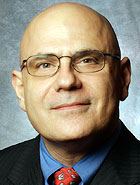A strict regimen of brushing the teeth of patients in the intensive-care unit on breathing machines dramatically reduced the bacteria that can cause up to 300,000 cases of deadly pneumonia yearly.
In a study in the 24-bed Barnes-Jewish Hospital surgical and trauma intensive care unit, nurses found that they could cut the incidence of ventilator-associated pneumonia (VAP) by nearly half by simply brushing patients’ teeth twice a day and applying mouthwash to the inside of the mouth.

Buchman
“The study clearly demonstrates the importance of regimented dental hygiene in reducing VAP in the ICU,” said Timothy G. Buchman, M.D., Ph.D., the Harry Edison Professor of Surgery and chief of the Section of Acute and Critical Care Surgery at the School of Medicine and co-author of the study. “It also underscores how critical every aspect of the lifesaving care is that nurses bring to patients every day.”
The yearlong study, led by nurse specialists in the intensive care unit in conjunction with School of Medicine physicians, was published online in the Journal of Intensive Care Medicine.
VAP is the most common hospital-acquired infection in critically ill patients. It is a leading cause of complications and death and can add days or weeks to a hospital stay and up to $40,000 to the cost of a patient’s care.
“The longer a patient is on a ventilator, the more potential there is for other complications to occur,” said Lynn Schallom, a nurse specialist and co-author of the study. “If we can prevent VAP, we can get the patient off of the ventilator and out of the intensive care unit faster.”
The primary cause of VAP is the aspiration or inhalation of bacteria-contaminated saliva and mucus into the lungs. Previous studies found that using an antimicrobial mouthwash on heart patients could reduce the incidence of VAP.
“We were intrigued by the use of tooth brushing to remove plaque and bacteria in healthy volunteers and felt we should include it,” said Carrie Sona, a nurse specialist and co-author of the study. “We had no funding and did not want to err on the side of just doing mouthwash, so we did both tooth brushing and mouthwash to make the biggest impact.”
To further reduce the costs of the study, Sona and Schallom used regular hospital toothbrushes, which cost about 7 cents each. The total cost of the tooth-brushing regimen through the study was $2,187.49
Beginning in 2004, whenever a patient in the unit was placed on a ventilator, the nurses started a regimen of brushing the patient’s teeth for one minute every 12 hours followed by a mouthwash. The regimen continued until the patients were off the ventilators and breathing on their own.
At the end of a year, Sona and Schallom found that incidence of VAP had dropped from 5.2 percent (24 cases) in 2003 to 2.4 percent (10 cases) in 2004 — a drop of 46 percent. The practice has been adopted for ventilator patients throughout Barnes-Jewish Hospital, and the VAP rate has remained at 2.4 percent or lower.